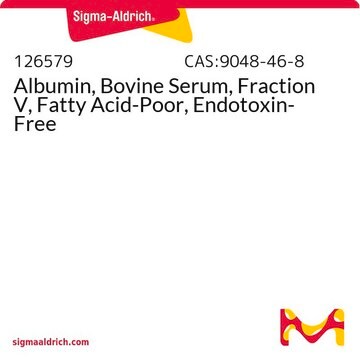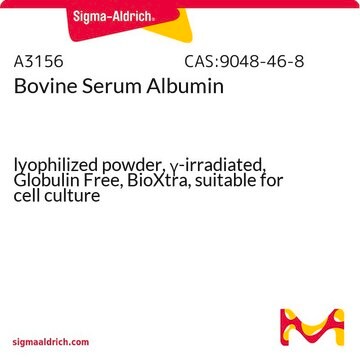A8806
Bovine Serum Albumin
fatty acid free, low endotoxin, lyophilized powder, BioReagent, suitable for cell culture, ≥96% (agarose gel electrophoresis)
Synonym(s):
Albumin bovine serum, BSA, Bovine albumin
About This Item
Recommended Products
biological source
bovine
product line
BioReagent
Assay
≥96% (agarose gel electrophoresis)
form
lyophilized powder
mol wt
~66 kDa
purified by
cold ethanol fractionation
packaging
poly bottle of
origin
USA origin
free fatty acid content
≤0.02%
technique(s)
cell culture | mammalian: suitable
impurities
≤0.02% fatty acid (GC)
≤0.1 ng/mg endotoxin
loss
≤5%
pH
4.8-7.5
solubility
water: soluble (40 mg/ml)
UniProt accession no.
foreign activity
AVA 9CFR 113.53, none detected
storage temp.
2-8°C
Gene Information
bovine ... ALB(280717)
Looking for similar products? Visit Product Comparison Guide
General description
BSA is a carrier protein for many biomolecules, such as fatty acids, amino acids, and steroids. For its carrier properties, BSA is also widely used in cell culture. BSA also serves antioxidant functions when used in cell culture.
Application
Because BSA is a well-known carrier of fatty acids (FA), control over the particular fatty acids used to culture cell lines is important, for cell culture lines which are sensitive to particular fatty acids. Fatty acid-free BSA is a highly useful reagent for such cell culture experiments, to allow researchers to use such BSA as a carrier for their specific fatty acids specific to their cell culture system. This mitigates potential risks to the cells from FA′s that might be present in non-FA-free BSA.
This BSA product is specifically tested for the following properties:
- Fatty acid free / very low FA content
- Low endotoxin level
- Suitability to use in cell culture
Biochem/physiol Actions
Features and Benefits
- Tested for use in cell culture
- Fatty acid-free
- Low endotoxin
- Cold ethanol fractionated
Preparation Note
Storage Class Code
11 - Combustible Solids
WGK
WGK 3
Flash Point(F)
Not applicable
Flash Point(C)
Not applicable
Personal Protective Equipment
Certificates of Analysis (COA)
Search for Certificates of Analysis (COA) by entering the products Lot/Batch Number. Lot and Batch Numbers can be found on a product’s label following the words ‘Lot’ or ‘Batch’.
Already Own This Product?
Find documentation for the products that you have recently purchased in the Document Library.
Customers Also Viewed
Articles
Explore serum albumin's role in serum-free cell culture systems for biomanufacturing.
Explore serum albumin's role in serum-free cell culture systems for biomanufacturing.
Explore serum albumin's role in serum-free cell culture systems for biomanufacturing.
Explore serum albumin's role in serum-free cell culture systems for biomanufacturing.
Protocols
Discover our protocol for thawing, plating, and forming hepatocyte spheroids from human spheroid-qualified plateable hepatocytes. Find the formulation for hepatocyte spheroid maintenance media.
Discover our protocol for thawing, plating, and forming hepatocyte spheroids from human spheroid-qualified plateable hepatocytes. Find the formulation for hepatocyte spheroid maintenance media.
Discover our protocol for thawing, plating, and forming hepatocyte spheroids from human spheroid-qualified plateable hepatocytes. Find the formulation for hepatocyte spheroid maintenance media.
Discover our protocol for thawing, plating, and forming hepatocyte spheroids from human spheroid-qualified plateable hepatocytes. Find the formulation for hepatocyte spheroid maintenance media.
Related Content
Learn about bovine serum albumin (BSA) structure, molecular weight, function, solubility, how BSA is made, purification methods, applications and purchasing.
Learn about bovine serum albumin (BSA) structure, molecular weight, function, solubility, how BSA is made, purification methods, applications and purchasing.
Our team of scientists has experience in all areas of research including Life Science, Material Science, Chemical Synthesis, Chromatography, Analytical and many others.
Contact Technical Service





